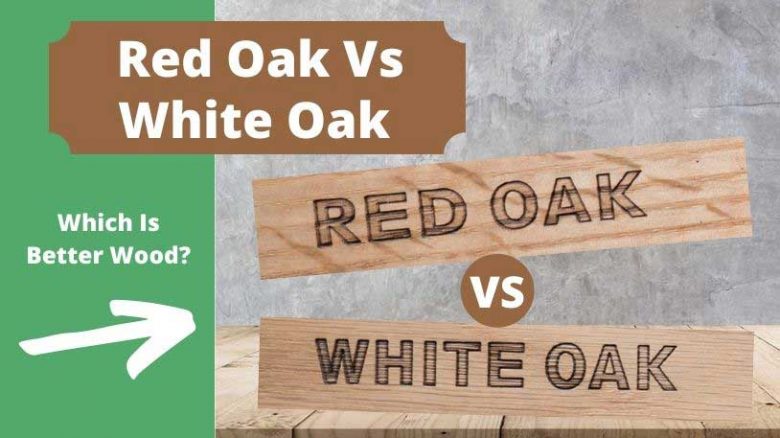Today, red oak and white oak are two of the most successful furniture and flooring materials. When people shop for furniture or flooring, they usually wonder, “What is the difference between red and white oak? And which one is superior?”
Of course, judging if red oak or white oak is “superior” is a personal choice reliant on your intended use for the wood.
Before you decide which oakwood to buy, consider the following facts, questions, and information about white oak wood and red oak wood. This guide will help you choose the hardwood that suits your unique needs.
Red Oak and White Oak Background
Red oak wood comes from a type of oak tree that belongs to the red oak family. The red oak tree is native to eastern and central North America, as well as southeast and south-central Canada.
White oak, like red oak, hails from Eastern North America. However, white oak is not as common as red oak. White Oak is used to construct boats and wine barrels because it is more resistant to dampness and rot.
Which Is Stronger, Red Oak or White Oak?
The Janka hardness scale acts as a tool to determine how hardwood is. The Janka test determines how much power is required to drive a steel ball into wood to a depth of half the diameter of the ball. Based on the Janka hardness scale, red oak is stronger than red oak.
Specifically, white oak wood has a Janka hardness rating of 1360, and red oak wood has a rating of 1290. The Janka hardness rating indicates that red oak is a bit more prone to dents and scratches than white oak.
Is Red Oak or White Oak Better for Furniture?
Both red oak and white oak are common variations of wood used to make furniture. Whether red or white oak is better for furniture depends on personal preference and use.

For example, red oak has open grains and is permeable. It has a higher tendency to shrink versus white oak. Red oak is ideal for indoor furniture since it polishes and stains quickly and does not blotch. Because the open pores of red oak collect stains, the grain patterns of the wood tend to become quite visible.
White oak is better suited for outdoor furniture since it is resistant to moisture due to its small pores. Additionally, white oak comes in a variety of colors. White oak furniture may be dark brown, light brown, or brown with yellow undertones. White oak looks better with a coat of stain or a coat of wood sealant.
However, just because red oak is better suited for indoor furniture and white oak furniture is better for outdoor furniture does not mean that the woods cannot work interchangeably. Some people may prefer white oak for indoor furniture since it is harder than red oak and less prone to denting.
Others may prefer red oak for outdoor furniture if their patio is enclosed. A person’s choice may simply come down to color preference. Either way, both red oak and white oak are great, safe options for furniture.
Related: Hardwood Vs. Softwood: Know The Difference
Which Is Cheaper To Purchase, Red Oak or White Oak?
Generally, red oak tends to be cheaper than white oak. However, prices vary. Depending on lumber supply, red oak may occasionally be more pricey than white oak. Additionally, manufacturers, distributors, wood grades, and measurements impact wood pricing.
Which Oak Has An Easier Staining and Finishing Process?
When it comes to staining processes, red oak takes stain evenly and does not splotch. White oak can be more difficult to stain evenly. This is because red oak has large pores, and white oak is close-grained.
Most red oak species have a very consistent deep color and stain evenly with little variation. However, red oaks from southern regions, for example, have a lot more color diversity than red oaks from the north.
After the staining and finishing process, the colors of white oak range from light brown to dark brown and dark yellow. Most white oak applications are less tolerant of color fluctuations than red oak applications.
Main Differences Between Red Oak and White Oak
In short, there are 5 key distinctions between red oak and white oak.
Price
Both red and white oak vary in price. Red oak is generally less expensive than white oak, but there are unique situations where this may not be the case.
Porousness
Red oak is always more porous than white oak. This indicates that red oak is not as water stain resistant as white oak.
Hardness
Based on the Janka hardness scale, white oak is slightly harder than red oak. This means that white oak is less likely to dent and split.
Color
White oak coloring has a wide range of brown tones. Red oak tends to be lighter and has more pink undertones.
Grain Patterns
Red oak grain patterns are more prevalent than white oak grain patterns.
Which Is The Better Wood, Red Oak or White Oak?
Both red oak and white oak are excellent choices. Oak is a hardwood ideal for furnishings and floors since it is durable and aesthetically pleasing. One cannot say which wood is entirely better since it mostly comes down to preference and how the wood will get used.
Still, when opting between red oak and white oak, there are several distinctions potential buyers need to be aware of.
Generally, white oak has a milder, more brownish tint and shorter rays than Red Oak, which has a warmer tone and shorter rays. Furthermore, the size of the rays and grain texture differ between both kinds of wood.
In terms of durability, white oak is stronger and more water-resistant than Red Oak, which some people prefer for furniture because of its tone and texture. Red oak may thus be the preferable option for heavily used furniture or in moist regions.
Overall, red oak and white oak have advantages that make both materials a wise option for furnishings.

